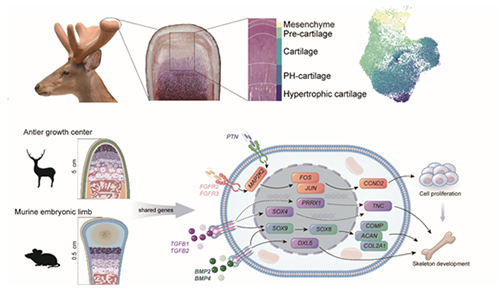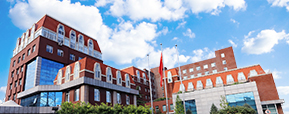Chinese scholars have made progress in the research of deer antlers regeneration and bone tissue repair/regeneration

Figure The cellular and molecular mechanism underlying deer antler regeneration
Supported by the National Natural Science Foundation of China (Grant No. 32225009, 31970392, 82122043, 32030016, 32122083 and U20A20403), the collaborative research teams by Prof. Qiang Qiu and Prof. Wen Wang from the School of Ecology and Environment of Northwestern Polytechnical University, Prof. Jinghui Huang from Xijing Hospital of the Fourth Military Medical University, Prof. Chunyi Li from Institute of Antler Science and Product Technology of Changchun Sci-Tech University, together with Prof. Zhipeng Li from College of Animal Science and Technology of Jilin Agricultural University, have achieved progress in the mechanism underlying the annual deer antler regeneration and its potential application in bone tissue repair. The research results were published online in Science on February 23rd, 2023 titled “A population of stem cells with strong regenerative potential discovered in deer antlers”. Article link: https://www.science.org/doi/10.1126/science.add0488
Human tissue or organ regeneration is one of the most important leading areas and listed in the “125 questions: Exploration and discovery” by Science in 2021. Some lower vertebrates have the ability to heal in a scar free manner and regenerate lost organ or appendages. However, the regeneration ability of mammals has gradually lost with the evolution of species. At present, the ability to regenerate organ in mammals is limited and incomplete. Therefore, understanding the biology underlying the regeneration of mammal (including human) organ or appendage could be of potential significance in tissue injury repair and anti-ageing.
The complete regeneration of appendages is a process that has fascinated and perplexed biologists for centuries. Most previous studies of the process have focused on non-mammalian vertebrates, such as axolotl and zebrafish. However, the distant phylogenetic relationship between non-mammalian vertebrates and humans limits their translation in medical research. Deer antler offers a unique model to study spontaneous regeneration in mammals. The researchers collected samples from eight stages of antler regeneration and constructed a cellular atlas of antler regeneration using single-cell transcriptome sequencing (scRNA-seq). Furthermore, the researchers identified a specific mesenchymal cell population and named it as "antler blastema progenitor cells (ABPCs)", which was the key driver of antler regeneration. Based on the spatial cellular atlas for the five tissue layers (from distal to proximal) of antler growth center, ABPCs was found at the antler tips as a stem cell pool for rapid antler growth.
Cross-species comparison showed that a cell type similar to ABPCs was present in mouse regenerative digit tip, but not in mouse nonregenerative digit tip, axolotl limb, or zebrafish caudal fin, suggesting that mammals and non-mammals may have distinct regeneration mechanisms. Further integrated analysis of the cellular atlas of antler regeneration and mouse embryonic limbs development identified 151 highly expressed genes associated with rapid skeletal development. Finally, the ABPCs showed a stronger ability in bone tissue repair than traditional BMSCs (Figure).
The study presents a spatiotemporal cellular and molecular atlas of rapid antler regeneration, which supplies a novel stem cell population for bone tissue injury and repair, and also provides a new strategy for mammalian organ regeneration research.
Contact Us

National Natural Science Foundation of China
Add: 83 Shuangqing Rd., Haidian District, Beijing, China
Postcode: 100085
Tel: 86-10-62327001
Fax: 86-10-62327004
E-mail: bic@nsfc.gov.cn
